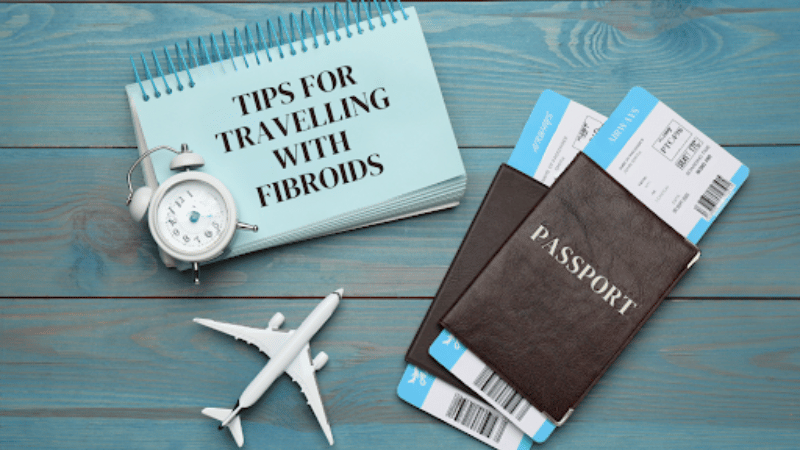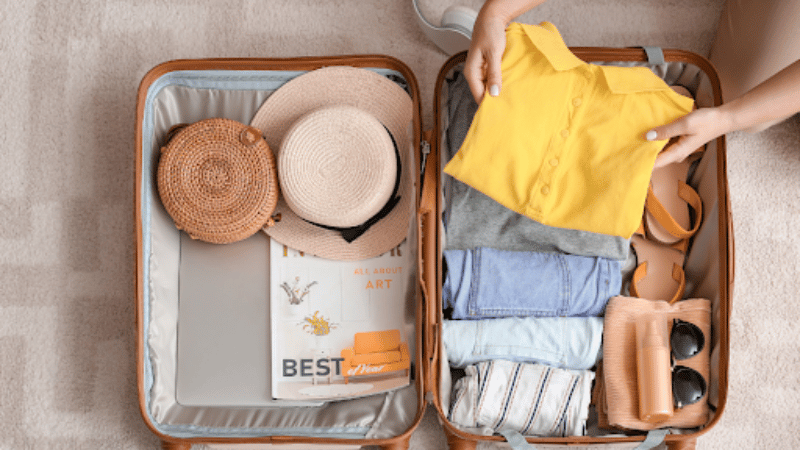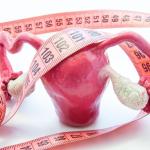
Managing fibroid symptoms while traveling can seem daunting, especially if you’ve just received a diagnosis. Whether you’re heading home for the holidays, embarking on a business trip, or planning a much-needed vacation, traveling with fibroids is possible if you prepare and learn the best ways to manage your fibroid symptoms.
Living with fibroids often means dealing with a range of symptoms that can vary in intensity, from mild discomfort to significant pain and inconvenience. These symptoms can become more pronounced during travel due to changes in routine, diet, and stress levels. However, with the right knowledge and preparation, you can mitigate these challenges and enjoy your travels.
In this guide, we’ll share essential tips and strategies to help you navigate the complexities of traveling with fibroids. From understanding how to manage pain and discomfort during long flights to packing needed essentials that support your well-being, we aim to provide you with the information you need for a smoother and more comfortable travel experience.
RELIEF IS A CLICK AWAY. REQUEST A CONSULTATION.
Preparing for Emergencies When Traveling
Traveling with fibroids requires careful preparation to effectively manage any potential flare-ups or emergencies.
Before embarking on your trip, allow yourself time to plan by scheduling a visit with your healthcare provider to discuss travel plans and obtain necessary medications. Also, ensure you have enough of what you need by assessing your current supply of medications and any of your other essentials for managing fibroid symptoms.

One of our top fibroid travel tips is to create a comprehensive packing list, including items such as:
- Anti-Inflammatory Medications: Pack enough anti-inflammatory medications to last the duration of your trip, and check that you have the prescribed dosage along with any instructions.
- Birth Control: If applicable, consider bringing birth control pills, as they can help with managing fibroid symptoms. Consult your healthcare provider to discuss whether birth control is a suitable option for you.
- Menstrual Supplies: Pack a sufficient quantity of overnight pads with heavy coverage to manage menstrual flow. You can also use period underwear in conjunction with pads for additional protection.
- Multivitamins: Include a supply of multivitamins in your travel kit, specifically iron supplements, to prevent anemia if you are prone to excessive bleeding.
- Hot Pad or Water Bottle: Bring a portable hot pad or a water bottle to soothe abdominal discomfort or cramps. Ensure the heating device is suitable for travel and adheres to airline safety regulations.
- Symptom Journal: Keep a symptom journal to track your fibroid symptoms throughout the trip. Note any changes, triggers, or patterns that may help you manage your condition more effectively.
Additional Fibroid Travel Tips:
- Research medical facilities at your travel destination in case you need medical attention.
- Have a copy of your medical records on hand, along with a list of emergency contacts.
- If you’re traveling with others, inform them about your condition (if you’re comfortable) and how they can assist in an emergency.
These preparation steps allow you to manage symptoms better while traveling with fibroids and address emergencies. If you have more questions about your specific situation, consult a healthcare provider for personalized advice.
Managing Fibroid Symptoms While Traveling
Managing fibroid symptoms while traveling requires proactive measures for a comfortable and stress-free experience. Here are some strategies to help navigate potential challenges and minimize flare-ups.
- Reduce Your Stress Levels: To minimize the impact of travel stress, adopt strategies prioritizing your well-being. Some ideas include planning your trip well in advance, giving yourself enough time to navigate the airport, and opting for earlier flights so you have more increased recovery time from traveling. Additionally, try relaxation techniques, like deep breathing or mindfulness exercises, to manage stress throughout your journey. Traveling in general, let alone traveling with fibroids, can be stressful, so allowing yourself plenty of time to handle any possible issues makes it easier to handle fibroid symptoms.
- Get a Good Amount of Sleep: Good sleep is paramount while dealing with fibroid symptoms during travel. One of the best ways to ensure good quality sleep is to adhere to a consistent sleep schedule, even when on the go, to regulate your body’s natural rhythm. It also helps to create a conducive sleep environment by finding ways to minimize disruptions using some combination of earplugs, headphones, or an eye mask.
- Eat a Healthy Diet: A well-balanced diet is essential when managing fibroid symptoms while traveling. Steer clear of inflammatory food and drinks such as alcohol, and instead opt for a good mix of fruits, vegetables, and whole grains. These dietary decisions help avoid inflammatory triggers and give you a more positive and comfortable experience while traveling with fibroids.
- Practicing Supportive Rest Positions: To relieve discomfort while managing fibroid symptoms during travel, try adopting supportive rest positions. If you’re experiencing discomfort, lie on a bed and place a pillow underneath your knees to alleviate pressure on your lower back. Alternatively, you may find relief by bringing your knees to your chest while lying down. These supportive rest positions can make you more comfortable for a more relaxed and manageable travel experience.
Adhering to these strategies can significantly enhance your experience traveling with fibroids. It’s important to prioritize self-care, listen to your body’s signals, and prepare a plan to address unexpected challenges during your journey.

Considering Long-Term Solutions: UFE for Travelers
As you adopt these strategies to manage fibroid symptoms during travel, it’s also worth considering long-term solutions for your fibroid-related issues.
One such solution is Uterine Fibroid Embolization (UFE), which is less invasive and highly successful when compared to traditional surgical procedures. Not only does UFE offer effective relief from fibroid symptoms, but its shorter recovery time makes it particularly attractive to women who love to travel or have active lifestyles.
The benefits of UFE can improve your quality of life. It does not cause scarring like surgical techniques, require a hospital stay or anesthesia and over 90 percent of women report excellent results and relief from painful fibroid symptoms.
By considering UFE, you can potentially reduce the challenges fibroids present, not only during travel but also improve your health and well-being year-round.

UFE and Travel
Undergoing a Uterine Fibroid Embolization (UFE) procedure can address various fibroid-related issues before traveling. UFE is a less invasive alternative to traditional surgical procedures, like hysterectomies, for treating fibroids. According to the National Institute of Health, UFE effectively alleviates fibroid-related symptoms for up to 92% of patients.1
Unlike traditional surgeries possibly involving the removal of the uterus or cutting uterine tissues, UFE eliminates fibroids by blocking their blood supply, hindering their ability to grow and thrive.
One notable advantage of UFE is the shorter recovery time, typically from one to two weeks. UFE is also an outpatient procedure, making it even more convenient and accessible.
Schedule Your Appointment Today
By opting for UFE, you can experience relief from fibroid symptoms without extensive surgery or prolonged recovery periods, making UFE ideal for managing your fibroids before traveling.
Schedule a consultation today for more information about UFE by making an appointment online or calling 855.615.2555 to visit one of our fibroid centers.
References
- Antony Raikhlin, Mark Otto Baerlocher, and Murray R Asch, “Uterine Fibroid Embolization: CME Update for Family Physicians,” Canadian family physician Medecin de famille canadien, February 2007, https://www.ncbi.nlm.nih.gov/pmc/articles/PMC1949124/.



